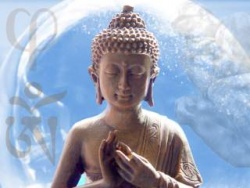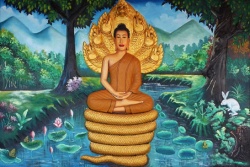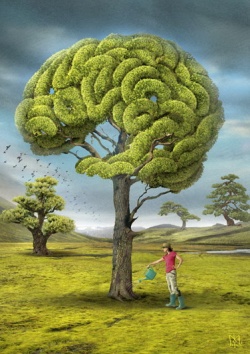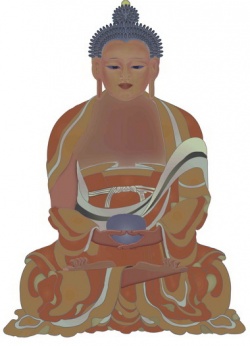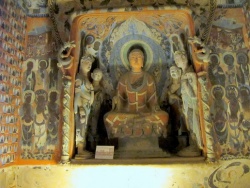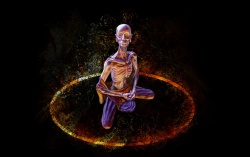Thai Forest Tradition
The Thai Forest Tradition is a tradition of Buddhist monasticism within Thai Theravada Buddhism. Practitioners inhabit remote wilderness and forest dwellings as spiritual practice training grounds. Maha Nikaya and Dhammayuttika Nikaya are the two major monastic orders in Thailand that have forest traditions. The Thai Forest Tradition originated in Thailand, primarily among the Lao-speaking community in Isan.
The Thai Forest Tradition emphasizes direct experience through meditation practice and strict adherence to monastic rules (vinaya) over scholastic Pali Tipitaka study. Forest monks are considered to be meditation specialists. The Forest Tradition is usually associated with certain supernatural attainments (abhiñña). It is widely known among Thai people for its orthodoxy, conservatism, and asceticism. Because of these qualities, it has garnered great respect and admiration from the Thai people.
Adherents model their practice and lifestyle on those of the Buddha and his early disciples. They are referred to as 'forest monks' because they keep alive the practices of the historical Buddha, who frequently dwelt in forests, both during his spiritual quest and afterwards.[1]
Perhaps its most widely known representative was Ajahn Chah and in the UK Ajahn Sumedho. Outside Thailand, the Thai Forest Tradition exists in the United States, Australia, Canada, New Zealand, Switzerland, United Kingdom, Germany and Italy.
Origins
Reaction against scholasticism
In Thailand, Buddhism plays a central role in society. In the early 1900s, the urban monasteries often served as scholastic learning centers. Monks usually receive their education in monasteries and earn the rough equivalent of "graduate degrees" in Pali and Tipitaka studies, without necessarily engaging in the meditative practices described in the scriptures. During that period, it was also generally believed that it was no longer possible to achieve awakening. Because of the tendency in urban monastic life towards scholarship, debate, greater social activity and so on, some monks believed the original ideals of the monastic life (sangha) had been compromised. It was in part a reaction against this perceived dilution in Buddhism which led Ajahn Sao and Ajahn Mun to the simpler life associated with the forest tradition and meditation practice. Forest monasteries are situated far away from urban areas, usually in the wilderness or very rural areas of Thailand. One finds such monastic settings in other Buddhist countries as well such as Sri Lanka, Cambodia and Myanmar. The Forest Tradition revival is an attempt to reach back to past centuries before modernization, and reclaim old discipline standards, as an attempt to stave off increasing laxness in contemporary monastic life.
Teachers
In the early 1900s, Thailand's Ajahn Sao Kantasilo Mahathera and his student, Mun Bhuridatta led the Forest Tradition revival movement. In the 20th century notable practitioners included Ajahn Thate, Ajahn Maha Bua and Ajahn Chah. Theravada Buddhists regard the forest as part and parcel of the monastic training ground. As such, this training method was revived and maintained for the benefit of oneself and future generations.[3] Myanmar and Sri Lanka have had their own forest traditions.
It was later spread globally by Ajahn Mun's students including Ajahn Thate, Ajahn Maha Bua and Ajahn Chah and several western disciples, among whom the most senior is Luang Por Ajahn Sumedho.
Pali Canon
The Thai Forest Tradition draws its inspiration from Pali Canon teachings contained in the Sutta and Vinaya Pitakas, where the Buddha is frequently described as dwelling in forests.[4] In the Pāli discourses, the Buddha frequently instructs his disciples to seek out a secluded dwelling (in a forest, under the shade of a tree, mountain, glen, hillside cave, charnel ground, jungle grove, in the open, or on a heap of straw).[5] The Buddha himself achieved Awakening in a forest, under the foot of a Bodhi tree. In the Bhaya-bherava Sutta, the Buddha explained that the mental challenge he faced during his stay in the forest had aided his quest for Awakening.[6] There are many suttas in the Pali Canon where the Buddha instructs monks to practice in remote wilderness. Here are some examples:
In the Andhakavinda Sutta:
'Come, friends, dwell in the wilderness. Resort to remote wilderness & forest dwellings.' Thus they should be encouraged, exhorted, & established in physical seclusion.
In the Dantabhum Sutta:
Come you, monk, choose a remote lodging in a forest, at the root of a tree, on a mountain slope, in a wilderness, in a hill-cave, a cemetery, a forest haunt, in the open or on a heap of straw.
In the Maha-Saccaka Sutta:[9]
The household life is close and dusty, the homeless life is free as air. It is not easy, living the household life, to live the fully-perfected holy life, purified and polished like a conch shell. What if I, having shaved off my hair & beard and putting on the ochre robe, were to go forth from the home life into homelessness?
The Tradition in the West
This section needs additional citations for verification. Please help improve this article by adding citations to reliable sources. Unsourced material may be challenged and removed. (June 2012)
See also: Vipassana movement
The Thai Forest Tradition is one of the major monastic orders of Theravada Buddhism in the West.
United States
The western order (if one can speak of such a distinction) was founded by an American monk, Ajahn Sumedho (born Robert Jackman), at the request of his teacher Ajahn Chah. The first monastery (Wat Pah Nanachat - 'International Forest Monastery') was founded in Thailand for the training of western bhikkhus in 1975.
Another monastery is Abhayagiri, about 13 miles (21 km) north of Ukiah, the monastery has its origins in the 1980s when the UK-based Ajahn Sumedho, foremost western disciple of the Thai meditation master Ajahn Chah, started getting requests to teach in California. Visits by either himself or one of his senior monks or nuns resulted in the Sanghapala Foundation being set up in 1988. The monastery's first 120 acres (0.49 km2) were given to the foundation by the devotees of Chan Master Hsuan Hua, founder of the City of Ten Thousand Buddhas in Talmage, before he died in 1995. Currently, the monastery rests on 280 acres (1.1 km2) of mountainous forest land.
A well-known American monk is Thānissaro Bhikkhu, also known as Ajaan Geoff, (born 1949) is an American Theravada Buddhist monk of the Dhammayut Order (Dhammayutika Nikaya), Thai forest kammatthana tradition. He is currently the abbot of Metta Forest Monastery in San Diego County. Ṭhānissaro Bhikkhu is a notably skilled and prolific translator of the Pāli Canon.[10] He is also the author of many free Dhamma books.[11]
England
Chithurst Buddhist Monastery was the first English monastery. In 1976, Ajahn Sumedho met George Sharp, Chairman of the English Sangha Trust. The Trust had been established in 1956 for the purpose of establishing a suitable residence for the training of Buddhist monks in England. By the 1970s, the Trust possessed a property in Hampstead that was not yet deemed suitable for what was desired. During a brief stay in London in 1978, Ajahn Sumedho, while undertaking the traditional alms round of Theravada monks (on Hampstead Heath), encountered a lone jogger who was struck by the Bhikkhu's outlandish attire. The jogger had, by chance, just acquired a piece of overgrown woodland in West Sussex. After expressing an interest in Buddhism, the gentleman attended a ten day retreat at the Oaken Holt Buddhist Center near Oxford after which he offered the forest as a gift to the Sangha. In 1979 George Sharp purchased Chithurst House (a property adjacent to the wood) on behalf of The English Sangha Trust. Chithurst House gained legal recognition as a monastery in 1981. The monastery was named Cittaviveka, a Pali word meaning "the mind of non-attachment".
Harnham Buddhist Monastery, Aruna Ratanagiri was founded in June of the same year. Amaravati Buddhist Monastery (now the main headquarters of the U.K. monasteries) was established in 1984 and formally opened in 1985. A fourth location is The Forest Hermitage (Santidhamma & Bhavanadhamma) (founded by Ajahn Khemadhammo).
Other western countries
The Thai Forest Tradition also exists in:
Australia (Ajahn Brahm, Bodhinyana Monastery, Bodhivana Monastery),
Canada,
New Zealand,
Switzerland (Kloster Dhammapala monastery)
Germany (Muttodaya Waldkloster Forest Monastery, Metta Vihara and Anenja Vihara)
Italy (Santacittarama monastery)
Practices
This section needs additional citations for verification. Please help improve this article by adding citations to reliable sources. Unsourced material may be challenged and removed. (June 2012)
Meditation
Main article: Vipassana
Meditation is a central component in the Thai forest tradition. Methods of meditation are numerous and diverse.
Ajahn Sao Kantasilo Mahathera and Ajahn Mun Bhuridatta
Meditation methods frequently used by Ajahn Sao Kantasilo Mahathera and his student, Ajahn Mun Bhuridatta, are the walking meditation and the sitting meditation. Outside the sitting meditation session, the practitioner must be aware and mindful of his or her body and mind movements in all positions: standing, walking, sitting and lying. During sitting meditation, the mind is calmed with traditional practices such as mindfulness of breathing (anapanasati). The mental intoning of the mantra "Buddho" is used in order to maintain attention on the breath (in-breath is "Bud", out-breath is "dho") or the contemplation of the 32 body parts. The meditator goes through three levels of samadhi (concentration). In khanika-samadhi the mind is only calmed for a short time. In upacara-samadhi, approach concentration lasts longer. And in appana-samadhi, jhāna is attained. When sufficient concentration has been established, the three marks of existence (impermanence, suffering, and non-self) are contemplated, insight arises and ignorance is extinguished. No distinction is made between samatha meditation and insight (Vipassanā) meditation; the two are used in conjunction.
Luangpor Teean Jittasubho
Luangpor Teean Jittasubho was a forest monk and a contemporary meditation master. He developed a meditation technique called Mahasati meditation. This method is a short cut for cultivating awareness. The practitioner pays attention to his or her body movements in all positions: standing, walking, sitting and lying. If the practitioner is aware of him or herself, then moha "delusion" will disappear. Mahasati Meditation does not call for reciting "in" or "out". There is no need to know whether one's exhalations or inhalations are long or short, fine or coarse, nor any need to perform rituals. This practice has frequently been called satipatthana because it is very similar to the method taught by the Buddha, in the Pali Canon, in the suttas of the same name (Maha Satipatthana Sutta found in the Digha Nikaya, sutta 22, Satipatthana Sutta found in the Majjhima Nikaya sutta 10, and an entire book where this practice is detailed throughout many short suttas, found in the Samyutta Nikaya section 47, titled "Satipatthana Samyutta"), but whatever people call it the point is to be aware of oneself. When thought arises the practitioner sees it, knows it and understands it. When he or she sees it, thought stops by itself. When thought stops, panna "knowing" arises, and she or he knows the source of dosa – moha – lobha "anger – delusion – greed". Then dukkha "suffering" will end.
Vassa (Rains Retreat)
Vassa (in Thai, phansa), is a period of retreat for monastics during the rainy season (from July to October in Thailand). Many young Thai men traditionally ordain for this period, before disrobing and returning to lay life.
Precepts and Ordination
There are several precept levels: Five Precepts, Eight Precepts, Ten Precepts and the Patimokkha. The Five Precepts (Pañcaśīla in Sanskrit and Pañcasīla in Pāli) are practiced by laypeople, either for a given period of time or for a lifetime. The Eight Precepts are a more rigorous practice for laypeople. Ten Precepts are the training-rules for samaneras (male) and samaneris (female), novice monks and nuns. The Patimokkha is the basic Theravada code of monastic discipline, consisting of 227 rules for monks (bhikkhus) and 311 for nuns (bhikkhunis).
Temporary or short-term ordination is so common in Thailand that men who have never been ordained are sometimes referred to as "unfinished." Long-term or lifetime ordination is deeply respected. The ordination process usually begins as an anagarika, in white robes.
Customs
A prominent characteristic of the Forest Tradition is great veneration paid toward Sangha elders. As such, it is vitally important to treat elders with the utmost respect. Care must be taken in addressing all monks, who are never to be referred to solely by the names they received upon ordination. Instead, they are to be addressed with the title "Venerable" before their name, or they may be addressed using just the Thai words for "Venerable," Ayya or Than (for men). All monks, on the other hand, can be addressed with the general term "Bhante". For monks and nuns who have been ordained 10 years or more, the title Ajahn, meaning "teacher", is reserved. For community elders the title Luang Por is often used, which in Thai can roughly translate into "Venerable Father".
In Thai culture, it is considered impolite to point the feet toward a monk or a statue in the shrine room of a monastery. It is equally considered impolite to address a monk without making the anjali gesture of respect. When making offerings to the monks, it is considered inappropriate to approach them at a higher level than they are at - for instance, if a monk is sitting it would be inappropriate to approach that monk and stand over them while making an offering.
In practice, the extent to which this cultural code of behavior is enforced will vary greatly, with some communities being more lax about such cultural codes than others. The one element which the forest monastic community are not lax about is the standard Theravada monastic code (vinaya).
Although Forest monasteries exist in extremely rural environments, they are not isolated from society. Monks in such monasteries are expected to be an integral element in the surrounding society in which they find themselves.
Teachers
[[Ajahn Sao Kantasilo Mahathera
Luang Por Mun Bhuridatta
Luang Por Waen Sujinno
Ajahn Plien Panyapatipo
Ajahn Lee Dhammadharo
Buddhadasa Bhikkhu
Luang Ta Maha Bua
Ajahn Chah
Ajahn Sumedho
Ajahn Khemadhammo
Ajahn Sucitto
Thanissaro Bhikkhu
Ajahn Munindo
Ajahn Thiradhammo
Ajahn Anando
Ajahn Sona
Ajahn Ganha
Ajahn Pasanno
Ajahn Brahm
Ajahn Sundara
Ajahn Candasiri
Ajahn Amaro
See also
Vipassana movement
Buddhist modernism
References
according to the Pāli Canon
Tiyavanich K. Forest Recollections: Wandering Monks in Twentieth-Century Thailand. University of Hawaii Press, 1997.
"Jinna Sutta". Access to Insight. Retrieved 2010-08-13.
In the following suttas, the Buddha dwells in forests: MN 105, MN 122, AN 3.34, AN 5.30, AN 5.34, AN 5.121, AN 5.180, AN 6.42, AN 8.53, AN 8.86, SN 7.18, SN 36.7, SN 36.8, SN 55.30, SN 56.31, SN 56.45, This list is not exhaustive as there are many more related suttas.
In these suttas, the Buddha instructs monks to stay in the forest in order to aid their meditation practice DN 2,DN 11,DN 12,DN 16, MN 4,MN 10, MN 27,MN 39,MN 60,MN 66,MN 101, MN 105, MN 107, MN 125, AN 4.259, AN 5.75, AN 5.76, AN 5.114, AN 10.60, Sn 1.12, Sn 3.11, SN 11.3, SN 22.80, This list is not exhaustive as there are many more related suttas.
"Bhaya-bherava Sutta". Access to Insight. Retrieved 2010-08-13.
"Andhakavinda Sutta". Access to Insight. Retrieved 2010-08-13.
"Dantabhumi Sutta". Access to Insight. Retrieved 2010-08-13.
"Maha-Saccaka Sutta: The Longer Discourse to Saccaka". Retrieved 2010-06-21.
Chah 2010.
Orloff 2004.
Sources
Chah, Ajahn (2010), Not for Sure: Two Dhamma Talks, Abhayagiri Foundation, translated from Thai by Thanissaro Bhikkhu.
Chah, Ajahn, (1991), A taste of Freedom. Bung Wai Forest Monastery.
Kornfield, Jack, (1986), A Still Forest Pool. London, Theosophical Publishing House.
Orloff, Rich (2004), "Being a Monk: A Conversation with Thanissaro Bhikkhu", Oberlin Alumni Magazine 99 (4)
Taylor, J.L., (1993), Forest Monks and the Nation-State: An Anthropological and Historical Study in Northeastern Thailand. Singapore: ISEAS, 1993 [1996]. ISBN 981-3016-49-3 (original study of forest monks in Thailand)
Tiyavanich, Kamala (1997), Forest Recollections: Wandering Monks in 20th Century Thailand. University of Hawaii Press, 1997. ISBN 0-8248-1781-8.
